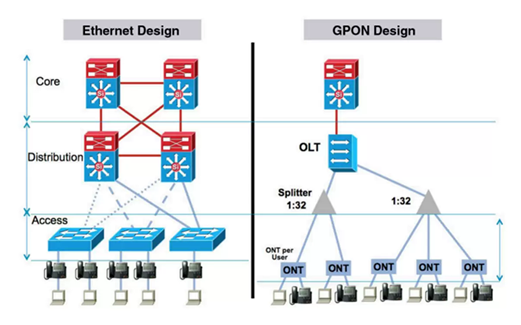Gigabit Passive Optical Network (GPON) is a communication technology used for fiber to home (FTTH) broadband installation. The GPON architecture has two key devices: Optical Line Terminal (OLT) and Optical Network Terminal (ONT). These two components are responsible for establishing reliable communication between the service provider network and the client point. As consumers' Internet bandwidth requirements soar and become more complex, they become more indispensable. This blog post will explore how these basic components work together to form a powerful access network through fiber optic infrastructure. You will have a better understanding of their role in GPON deployment and tips to ensure successful installation and performance.
Understand GPON technology

network diagram
The simplest form is that GPON represents a gigabit passive optical network. It is a fiber optic communication technology that enables efficient and economical long-distance data transmission. GPON is the preferred technology for fiber optic networks as it can support multiple network architectures, from small home networks to large enterprise networks.
How does GPON work?

Technical Overview
The working principle of GPON is to use single-mode fiber optic cables to transmit data through optical signals. The main components of the GPON system include optical line terminals (OLT), optical network units (ONUs), and passive optical splitters. OLT is responsible for downlink data transmission, while ONU is responsible for uplink data transmission. The passive optical splitter is responsible for dividing the optical signal into multiple signals that can be allocated to the end user.
When transmitting data, it is first compressed and packaged into small packets, and then sent to OLT. OLT then uses multiple wavelengths to transmit the data to the passive splitter. Once the signal reaches the passive optical splitter, it will be divided into various prompts and sent to the ONU connected to the splitter. Finally, the data is transmitted from the ONU to the end user.
The advantages of GPON technology
The advantages of GPON technology are numerous and diverse. One of the main advantages of GPON technology is its high bandwidth. GPON technology can support downlink speeds of up to 2.5 Gbps and uplink speeds of up to 1.25 Gbps. This high bandwidth makes it possible to quickly transmit large amounts of data over long distances.
Another benefit of GPON technology is its scalability. No new fiber optic cables need to be installed to add new users to the GPON network. This is because GPON technology adopts a point-to-point architecture, which means multiple ONUs can be connected to a single OLT.
Finally, GPON technology is cost-effective. It is possible to implement GPON technology at a lower cost than traditional copper wire technology. This enables service providers to provide high-speed Internet, IPTV and other digital services at a lower price.
Practical examples
GPON technology has been successfully deployed in many regions around the world. Some of the most famous examples include Japan, which has used GPON to provide high-speed broadband services for residential and corporate customers. In India, GPON has been used to provide digital services to remote villages where traditional copper wire technology is not available or reliable. In Europe, GPON has been deployed to provide high-speed Internet and digital services for public institutions such as libraries, schools and hospitals.
The role of Optical Line Terminal (OLT)

Application diagram
Image source: optokon.com
As the backbone of Gigabit Passive Optical Networks (GPONs), Optical Line Terminals (OLTs) serve as the central interface between service providers and customers. OLT is an optical network device that aggregates and distributes data through multiple optical network units (ONUs) located at the customer's premises. It is an important equipment in modern telecommunications infrastructure, enabling service providers to provide high-speed Internet, television and voice services for their customers.
The definition and role of OLT
OLT is a high-capacity device that acts as a transmission endpoint in a GPON network. It is responsible for converting electronic data into optical signals and transmitting them to the customer's location through fiber optic cables. OLT aggregates traffic from multiple ONUs to ensure efficient transmission of data across the entire network. It provides various basic functions, including packet switching, traffic scheduling, and quality of service (QoS) management.
OLT composition
OLT consists of multiple components, including a central processing unit (CPU), register memory (RM), uplink transceiver (Tx)/downlink receiver (Rx), and power supply unit (PU). The CPU manages and controls the entire OLT operation, while RM stores OLT configuration files. The Tx and Rx units send and receive data through the network, while the PU provides power to the device.
Using OLT in GPON networks
In the GPON network, OLT sends and receives data through an Optical Distribution Network (ODN). ODN is a passive network consisting of optical cables, splitters, and couplers connecting ONU and OLT. OLT uses specific protocols, such as the Gigabit Passive Optical Network (G-PON) protocol, to transmit data through ODN downlink and uplink. The downlink data is sent from OLT to ONU, and the uplink data is sent from ONU to OLT. OLT adopts the Optical Time Division Multiple Access (OTDMA) protocol to manage uplink data transmission and ensure that data transmission is conflict free.
In summary, Optical Line Terminals (OLTs) play a crucial role in the operation of Gigabit Passive Optical Networks (GPONs). It manages and controls data transmission between service providers and customers. OLT is composed of multiple important components, including CPU, RM, Tx/Rx, and PU, which work together to ensure reliable and efficient connections. By understanding the basic functions of OLT in GPON networks, service providers can provide their customers with high-speed and reliable services.
The role of optical network terminals (ONT)

Optical Network Terminal (ONT) is an important component of Fiber to Home (FTTH) networks. It connects the last mile of fiber optic cable to end-user devices, which can be computers, routers, or telephones. It can distribute multiple services through a single fiber, including high-speed Internet, voice and video. Its main function is to convert optical signals transmitted through optical cables into electrical signals that can be understood by end user equipment.
Composition of ONT
ONT consists of multiple key components that work together to ensure seamless and reliable data transmission. The first important component is the Optical Line Terminal (OLT), which aggregates traffic from multiple ONTs. It is responsible for routing and forwarding data packets between ONT and the core network. The second component is the power supply, which provides power for ONT. The third component is a fiber optic transceiver, which receives and transmits signals through fiber optic cables. The fourth component is an Ethernet switch, which supports communication between ONT and end-user devices. Finally, the management interface provides access to ONT configuration settings and status information.
Using ONT in GPON networks
In gigabit passive optical networks (GPONs), ONT plays an important role in transmitting data from optical line terminals (OLTs) to end-user devices. ONT receives downlink signals transmitted through optical cables from OLT. Then, it converts these optical signals into electrical signals that the end user device can understand. ONT then transmits the uplink signal to OLT through optical cables, achieving bidirectional communication. ONT also performs various functions such as data encryption, quality of service (QoS) management, and network management.


